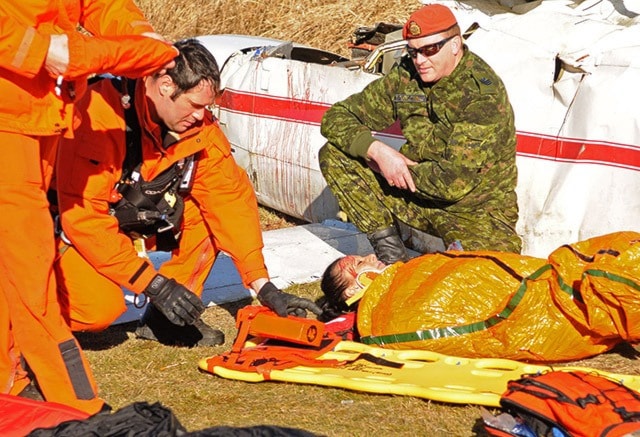On Friday morning, about 20 minutes before the Royal Canadian Air Force Squadron 422 search and rescue training exercise starts, Kim Dickson and Charline Rolston stroll over to the crumpled wreckage of an airplane. Looking more like a stepped-on pop can than anything that ever flew, it lies with its back pressed against the bank of a canal running parallel to a runway at the Chilliwack airport.
Dickson and Rolston look it over, then Dickson does something curious. She climbs into the open cockpit, flops her torso and arms over the side and closes her eyes.
Strange time for a nap?
Not at all.
With blood stains on her checks and a bloody protrusion that keeps falling off of her forehead, she is prepping to simulate  victim number one. Her job will be to stay still and keep her eyes shut for the duration.
victim number one. Her job will be to stay still and keep her eyes shut for the duration.
Rolston settles in with her back against the airplane’s hull. She wraps herself in a foil blanket as she prepares to be victim number two. She will play the role of a type-one diabetic, severely disoriented by the crash.
When the search and rescue technicians (SAR Techs) arrive, she’ll start wandering around, trying to leave the scene. Job one will be to keep her in one place. Both women are volunteers with the Civil Air Search and Rescue Association (CASARA), a group that lends what assistance it can in search and rescue efforts.
Soon, they hear a sound in the distance.
The source is easy to spot, even from a few miles off. The CC-115 Buffalo aircraft is 24 metres long, with a 29.2m wingspan. It’s also painted a bright shade of orangy-yellow.
Over the next 20 minutes it circles the scene, at one point dropping three colored streamers from the back.
Where they are dropped and where they land helps the SAR Techs gauge wind-speed – helpful to know when you’re about to parachute from a moving plane. In a real situation, misjudging wind could result in a SAR Tech getting stuck in a tree or worse.
On this morning, the wind is howling in Chilliwack. Airport readings have it at 30 knots, or five above the safety threshold. In a real operation, the safety thresholds would be different and the SAR Techs would be jumping. But in training, they don’t want to leap out and drift onto the freeway. So the SAR Techs wait until it lands before making their way to the scene.
With practiced efficiency they do their thing.
Dickson is assessed, carefully removed from the wreckage, strapped to a backboard and bundled up nice and warm.
Rolston is corralled, not an easy thing to do as she plays her rattled role to perfection. She is eventually wrapped in a blanket and given an IV drip.
Within minutes the huge and loud CH-149 Cormorant helicopter arrives with additional personnel. It is built to function in extreme and remote environments, capable of flying 1,000 kilometres without refueling. Apparently, it is the envy of Squadron 422’s U.S. counterparts.
 As it hovers 50 feet overhead, verbal communication is impossible. Everything is hand gestures. Four SAR Techs pick up Dickson’s backboard and carry her to the chopper, which has landed nearby. The big whirlybird is capable of carrying up to 12 stretchers or 5,000 kilograms, and she’s a lot lighter than that.
As it hovers 50 feet overhead, verbal communication is impossible. Everything is hand gestures. Four SAR Techs pick up Dickson’s backboard and carry her to the chopper, which has landed nearby. The big whirlybird is capable of carrying up to 12 stretchers or 5,000 kilograms, and she’s a lot lighter than that.
Once Dickson is loaded in, off it goes. In a real situation, it would head to the nearest hospital. On this morning it heads back to Squadron 422’s temporary base at the Abbotsford airport.
And with that, the exercise is over. With three days of training in the books, Squadron 422 packs up and heads back to Comox.
In a perfect world, the skills they practiced here would never be needed. But they cover 920,000 square kilometres of B.C. and Yukon territory, plus 500 nautical miles of Pacific Ocean, and the world is not perfect.
The night before their Chilliwack training exercise, SAR Techs were busy saving a man’s life in Jervis Inlet, a remote spot about 26 kilometres north of Egmont. Going way too fast and too close to shore, he’d run his boat onto rocks, gashing a two-foot hole in the aluminum hull.
With nowhere to safely land, a Cormorant helicopter dropped SAR Techs onto a beach. They stabilized the man’s injuries, which were serious, and airlifted him out. He was taken to Powell River airport, transferred to an air ambulance and sent on to Vancouver General Hospital.
Because of what the SAR Techs did, he will live.
So accidents happen, and the next time an airplane crashes in a forest or a boat runs aground in a coastal inlet, they will be called. And because of what they did in Chilliwack, they’ll be ready.
